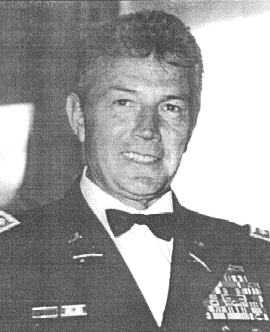Richard J. Meadows facts for kids
Quick facts for kids
Richard J. Meadows
|
|
|---|---|
 |
|
| Nickname(s) | "Dick" |
| Born | June 16, 1931 Johnson Creek, Alleghany County, Virginia, U.S. |
| Died | July 29, 1995 (aged 64) Ft. Walton Beach, Florida, U.S. |
| Buried |
Ft. Walton Beach, Florida, U.S.
|
| Allegiance | United States |
| Service/ |
United States Army |
| Years of service | 1947–1977 |
| Rank | Major |
| Unit | 75th Ranger Regiment United States Army Special Forces Special Air Service MACV-SOG |
| Battles/wars | Korean War Vietnam War Operation Ivory Coast Operation Eagle Claw |
| Awards | Distinguished Service Cross Silver Stars (2) Bronze Star with V Device Air Medal Legion of Merit Combat Infantryman Badge Master Parachutist badge Ranger Tab Scuba Badge |
Richard James Meadows (June 16, 1931 – July 29, 1995) was a U.S. Army Special Forces officer who saw combat in Korea and Vietnam. He was a key figure in the Iran Hostage Rescue mission in 1980. He was a pivotal player in the creation of the modern U.S. Army Special Forces.
Career
Meadows enlisted in the Army in 1946 at age 15. He first saw combat as a paratrooper in Korea and was, by age 20, the youngest Master Sergeant in the Army at that time. In 1953, he entered the U.S. Army Special Forces and remained active in them or the Rangers until his retirement in 1977. His participation in the Iran Hostage Rescue mission came after his official retirement.
In 1960, Meadows was one of the first U.S. Army officers to participate in an exchange program with the British Special Air Service special forces unit. Meadows completed SAS training, was an acting troop leader for 12 months, and participated in a field combat operation with his unit. Meadows' SAS experience may have helped form the basis for future US Army Special Forces selection, training, and organizational structures.
Vietnam War
While assigned to the 8th Special Forces Group in Panama, MSgt. Meadows volunteered for a tour in Vietnam. Meadows served his first tour in the Military Assistance Command, Vietnam - Studies and Observations Group (MACV-SOG), where he participated in numerous deep reconnaissance missions in Laos and North Vietnam. During one such operation he captured high-quality film of North Vietnamese foot soldiers traversing South Vietnamese territory, directly contradicting the claims of the North Vietnamese government. On another occasion, he rendered several enemy artillery pieces useless by removing their sights, one of which was given to General William Westmoreland. Meadows' exploits so impressed Westmoreland that Meadows was given a battlefield commission on April 14, 1967.
In 1970, Captain Meadows was pulled from his position as commanding officer of Ranger School in Fort Benning and made a team leader for the initial assault team in the Son Tay prison camp raid (see Operation Ivory Coast). This 14-man team (plus pilots), code-named Blueboy, intentionally crash-landed an HH-3 helicopter right in the middle of the prison camp to achieve maximum surprise. One team member was injured in the landing (broken ankle). The remaining team members executed their mission without further casualties. Much to Meadows' disappointment, however, the enemy had moved all its captives weeks earlier.
In the mid-1970s, Meadows was a key figure in the founding of the Delta Force special operations and hostage rescue force.
Meadows retired from the Army as a major after 31 years of service in 1977.
Later life and death
In 1980, Meadows returned to service as a special consultant and, posing as an Irish businessman in the European automotive industry, provided covert reconnaissance of the U.S. Embassy in Tehran prior to and during Operation Eagle Claw, better known as the Iran Hostage Rescue mission. Meadows was tasked with reconnoitering the embassy grounds, locating the hostages, and renting trucks to abet the hostage rescuers. That mission ended in a major accident at a ground refueling point in the Iran desert and was aborted. Although documents found at the crash site compromised both the mission and Meadows' cover in Iran, Meadows was able to escape Iran aboard a commercial flight with his cover intact.
In 1982, Meadows appeared on the cover of Newsweek magazine in an issue that had a feature article on Meadows.
In 1995, Meadows was diagnosed with and subsequently died of leukemia. It is contended by many in the Special Forces community that, had the contents of Meadows' military record been disclosed, he would have been awarded the Medal of Honor. Nonetheless, the majority of Meadows' covert roles in Vietnam working with the CIA's Special Activities Division remain undisclosed.
Awards and decorations
Major Meadows military decorations and awards include the following:
|
|
||||||||||||||||||||||||||||||||||||||||||||||||||||||||||||||||||||||||||
In addition to the above, Meadows received numerous foreign awards and was eligible after his retirement for the Korean War Service Medal from South Korea and the Special Forces Tab.
Just before his death, in July, 1995, Meadows was told he was to be presented with the Presidential Citizens Medal by President Clinton.
Legacy
On June 6, 1997, a statue and adjacent parade field near U.S. Army Special Operations Command building in Fort Bragg, North Carolina were dedicated in Meadows' memory.
Images for kids








